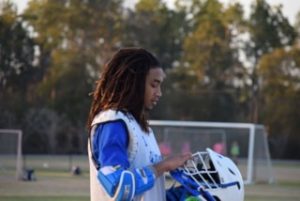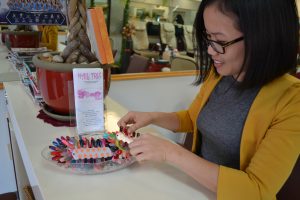
By Lauren Tarpley
“I make sure I’m grateful for every opportunity I get. If I could go back one year and give myself advice, I would say be appreciative.”
A lot can change in one year. One year ago, Jahdi’El “Jay” Arrington, 20, was living in Chapel Hill. Jay was reluctantly attending Durham Technical Community College, and he already had a few run-ins with law enforcement. Today, Arrington is attending St. Andrews University in Laurinburg, NC, on a scholarship doing what he his most passionate about, lacrosse.
Life changing opportunities do not happen by chance. These opportunities are born out of struggle, hardship and dedication. Arrington is a prime example of how one’s life can completely change with some ambition and support.
Originally from Ohio, Arrington moved to Chapel Hill while in middle school. A lack of stability had a negative impact on Arrington’s middle school career as multiple moves and switching schools led to poor grades. During this time he was enrolled in the mentor-partnership program Volunteers for Youth where he met his mentor, Eric Perry.
“I figured I needed to do something to give back a little, but as far as getting Jay—it was just the universe doing me a solid favor,” Perry said. “He’s had his struggles, but he has a wonderful heart and he was just the perfect kid for me to mentor.”
Arrington was 12 years old at the time and eight years later Perry continues to support and advise him.
“I’m not sure what it was that caused fate to sign on to it or how it worked, but the universe just lined everything up perfect. I fell in love the first time I met him. He was just a sweet little guy and that part of him never changed and never will,” Perry said.
Struggle to success
Perry helped Arrington work through tough situations in his youth such as transitioning schools, sometimes ending up in worse districts.
“He wasn’t with the same kids or teachers, and it was really hard for him,” Perry said. “He’s a get-along guy, but in this process, he was getting left behind in school.”
As Arrington got older, Perry remained by his side through good times and bad times. Arrington eventually graduated from East Chapel Hill High School and enrolled in Durham Technical Community College. While Arrington was hard-working and ambitious, he still had his faults. He would eventually be charged with a DUI, amongst other minor encounters with the law. Instead of falling victim to these hardships, Arrington used them as an opportunity to learn and grow from his mistakes.
“My struggles have helped me open my eyes to real-life situations. The obstacles that are in my way will be hard to deal with and will continue to challenge me, but all I have to do is give it everything I’ve got,” Arrington said.
Perry was a prominent figure through these difficult times, reminding Arrington that he is in control of his fate.
“He was twelve when we first started hanging out and he’s damn near a grown-ass-man now,” Perry said. “We all have some bumps along the way and if all is well at the end of the rail, we’ve learned something and have some grip on right and wrong.”
Thinking positive
Throughout their relationship, Perry has emphasized the importance of being proactive and positive in life, as our life reflects our thoughts.
“We kept talking about asking the universe for the next great thing,” Perry said. “Don’t go through life asking what terrible thing will happen next, because the universe will answer with what you ask for. But, the exact opposite is also true. I believe if you look in the mirror and ask for great things, great things will happen.”
According to Perry, every time they spoke, Arrington would say three things he was grateful for. Then, in January, Arrington received a phone call congratulating him on his admittance to St. Andrews University on a lacrosse scholarship. Arrington now had the opportunity to get an education at a four-year institution while playing the sports he is most passionate about—just one more thing to be grateful for.
“It’s been gratifying knowing he was able to make a connection between the change in his attitude and this amazing opportunity,” Perry said. “I’m proud of him. Super proud of him.”
A bigger issue at hand
While Arrington’s hardships were temporary obstacles on his path to success, these struggles often hinder young black Americans trying to succeed.
Black Americans are highly represented within the United States’ criminal justice system. According to The Sentencing Project , 32 percent of blacks males between the ages of 20 to 29 are under some form of criminal justice supervision– whether that be prison, probation, or parole. While white males born in 1991 have a four percent chance of spending time in prison, their black counterparts have a 29 percent chance of going to prison at some point during their lives, according to The Sentencing Project.
An article published on Slate.com reported on a Rhode Island study that found black drivers were more likely to be stopped than white drivers despite the fact that they are less likely to receive a citation. Furthermore, black Americans were three times as likely to have their cars searched and were less likely to have a reason for being stopped. Let’s take a moment to let that sink in.
Perry has emphasized the importance of being aware of the current racial tensions in our society, stating the alternatives to cooperation can be frightening for black Americans.
“If you’re young and black, it’s open season on you. So, you have to be super aware of that in a way that I wouldn’t have to. It’s unfair, but that is what’s going on,” Perry said.
These racial issues, on a larger scale, might be hard to relate to. But ,when these issues happen on a local level and effect loved ones, the reality becomes clear. Perry believes voting and movements such as Black Live Matters bring awareness to these issues and offer people a way to be proactive.
“If you want to change injustice in the system, and it’s loaded with it, you can’t change the system without being active,” Perry said. “That’s a simply fact,”
Jahdi’El Arrington – student athlete
Currently, Arrington is majoring in communications. He will be red-shirting as a midfielder on the men’s lacrosse team at St. Andrews.
“Now that I am in school, doing what I love and getting an education, I feel like I can start achieving more in life since I am learning so much as I go through this process,” Arrington said.
Edited by Luke Bollinger



